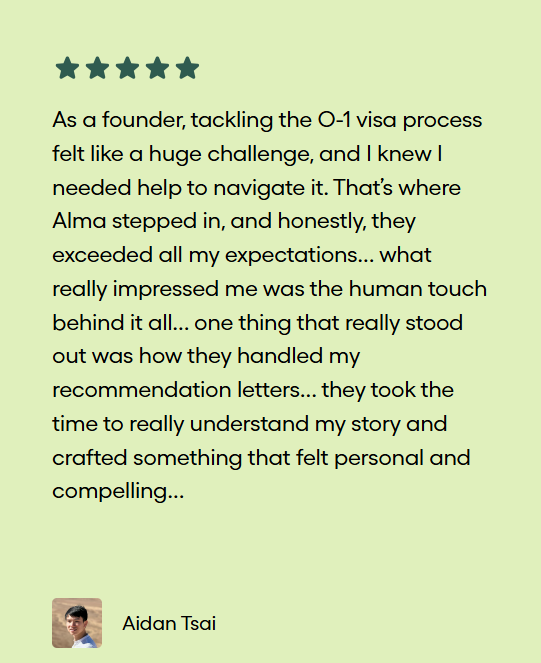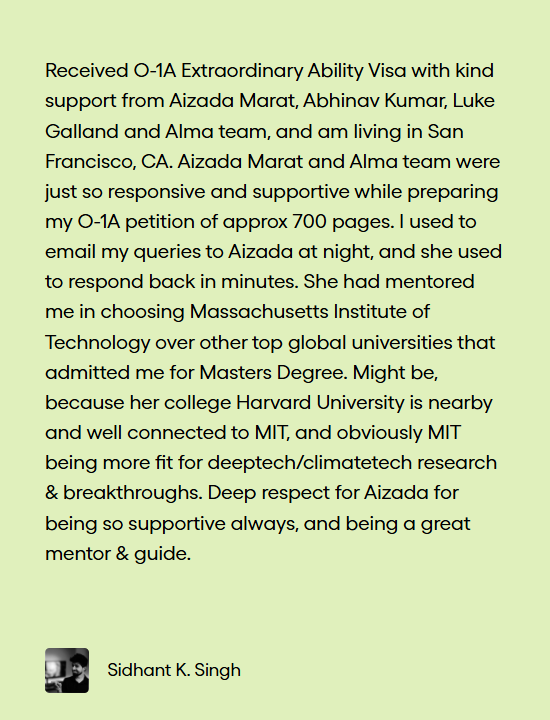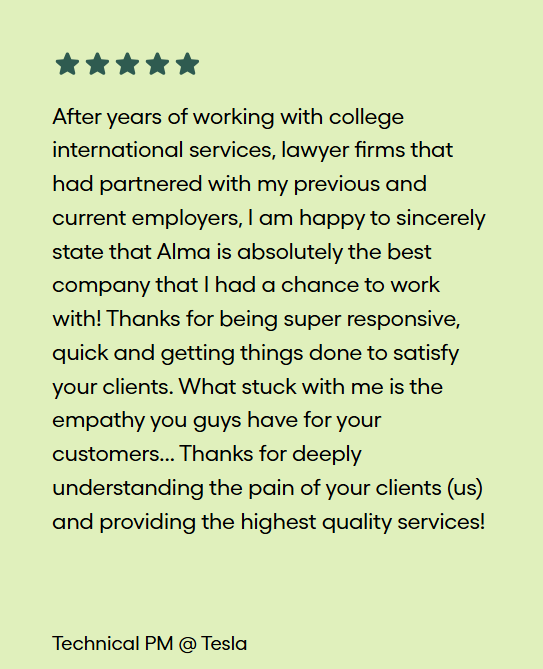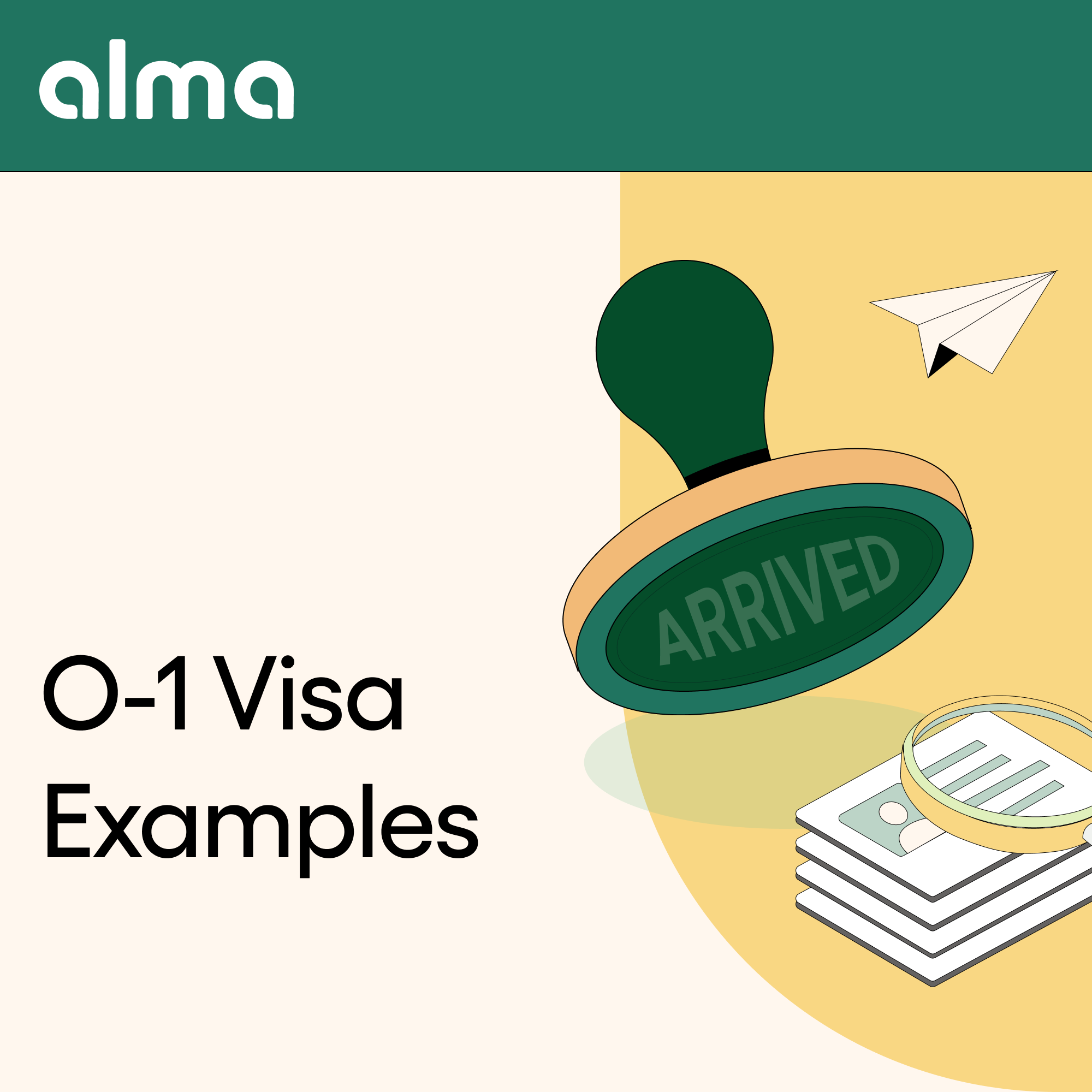- Many successful applicants for the O-1 visa qualify by demonstrating sustained, meaningful achievements in their field.
- Case studies and examples show successful approvals across diverse fields, including AI startups, music technology, and opera.
- Alma builds each petition around the applicant’s strongest qualifications, aiming to meet several of the USCIS criteria for O-1A or O-1B.
- We prepare O-1 petitions in as little as two weeks, with transparent pricing, no hidden fees, and a 99% success rate.
You don't need to be famous or get the Nobel Prize to qualify for the O-1 visa. Many successful applicants build strong cases by showing a track record of meaningful achievements, not just having one big moment of recognition.
What matters most is how well you tell your story. The O-1 visa is about showing “extraordinary ability” through clear evidence, strong accomplishments, and a well-organized narrative that highlights your impact.
In this article, we’ll share real examples of innovators and artists we’ve worked with who each qualified in their own way. For these cases, we identified the eligibility criteria that best matched each person's accomplishments and built a narrative around those strengths to show how they stood out in their field.
Alongside these examples, we’ll also walk through the O-1 application process to give you a sense of what it takes to build a strong, well-documented case from start to finish.
Curious if your story fits? Talk to our team to get an honest assessment before you apply.
Case Studies of Clients We Successfully Helped Obtain the O-1 Visa
1. An AI Founder Who’s Building the Future Through the O-1A Visa
Case Overview
An Indian startup founder and AI expert needed a way to stay in the U.S. long-term so he could focus on growing his company. Alma worked closely with him to prepare an O-1A petition that spotlighted his technical achievements, leadership, and reputation in the field.
After his visa was approved, he’s now free to continue building and advancing his work in the U.S. without worrying about immigration obstacles.
Background
For founders, engineers, and researchers shaping the future of artificial intelligence, the United States offers unmatched opportunities to grow and innovate. Yet for many international professionals, the immigration process can feel overwhelming, full of uncertainty, complex paperwork, and long waits.
We recommended that he apply for an O-1A visa, a category meant for individuals with exceptional talent in areas like science, technology, and business.

The Challenge: Building in the U.S. Without Long-Term Stability
After starting several companies and working at the forefront of AI, the client knew the U.S. was the right place to take his next startup to the next level. He had previously launched and sold a company focused on brainwave data, demonstrating his ability to push new ideas forward.
His work had gained attention; his past startup was chosen for a top life science incubator and was supported by a California-backed accelerator. He then co-founded a new AI venture in Boston and teamed up with researchers from MIT. To keep building without visa-related uncertainty, securing long-term stability through the O-1 visa became a major step in his journey.
But even with a strong track record, the visa application process wasn’t simple. The O-1 requires detailed proof of “extraordinary ability” across different areas, which can be challenging to put together, even for experienced founders.
The Solution: Constructing a Persuasive O-1A Petition Around AI Leadership
Getting an O-1 visa takes more than just having an impressive background. It requires telling your story in a way that clearly fits what the U.S. Citizenship and Immigration Services (USCIS) is looking for. Our team worked with the client to prepare a complete petition in just 14 days.
We explained his work in AI and technology in a way that matched the visa’s requirements, collecting strong recommendation letters from respected voices in venture capital, tech research, and the startup world.
We also showcased his leadership, both in growing companies and giving back through talks and mentoring. In the end, we built a clear, organized petition that showed why he deserved to live and work in the U.S.
The Outcome: O-1A Visa Approval & a Future in AI Innovation
With Alma’s guidance, his O-1A visa was approved. He can now stay in the U.S. and grow his AI company without worrying about issues surrounding his residence and visa. With his future solidly in place, he’s able to focus entirely on building, leading, and taking his work to the next level.
2. A Music Innovator Blending Creativity and Technology Through the O-1A Visa
Case Overview
A British-Malaysian music producer and AI expert wanted to stay in the U.S. long-term in order to continue working on new ways to create music using technology. Alma helped put together an O-1A visa application by focusing on what was unique in the beneficiary’s work that combined music and AI.
His visa was approved, and now he continues to push the boundaries of sound and technology in the U.S.
Background
This is a new kind of creator at the intersection of art and technology, who’s changing how we think about musical innovation. He’s a composer, producer, and technologist who combines artificial intelligence, sound design, and interactive media to push the limits of creativity.
The O-1A visa gave him the chance to keep building new tools that change how we make and experience music.
The Challenge: Redefining Musical Innovation in the Age of AI
The client had a unique career that combined both art and technology. He created algorithms to make and change music, built interactive sound systems, and worked on research that brought together scientists and artists.
But even with his impact, the immigration system doesn’t easily recognize fields like AI-driven music. His challenge was turning his wide-ranging work (creative projects, research, and tech inventions) into a clear story that fit the strict O-1A visa requirements.
The Solution: Framing Creative Technology as Extraordinary Ability
Alma’s legal and writing teams built a clear and focused strategy that showed he wasn’t just a technologist, but also an innovator in music and AI. In less than three weeks, we:
- Organized his key accomplishments, from tools that help create music using AI to major projects with well-known artists, into categories that meet O-1A visa requirements.
- Emphasized his unique role in creating machine learning systems that help with music-making and sound modeling.
- Highlighted his recognition in both science and art, including speaking at international conferences and performing in artistic events.
- Collected strong letters of support from AI experts, composers, and sound engineers who explained his impact on combining creativity with technology.
- Created a petition that told a clear, powerful story, one that showed how he’s pushing the boundaries of both music and science.
The final result was a visa application that combined solid proof with a compelling story, turning complex work into clear evidence of leadership and talent.
The Outcome: O-1A Approval & the Freedom to Build the Future of Sound
With Alma’s support, his O-1A visa was approved, giving him the freedom to keep building new ideas at the crossroads of art and technology in the U.S. This approval recognized not just what he had already done, but also his potential to push forward the fast-changing world of AI music and sound innovation.
Today, he’s creating new tools that blend human emotion, creativity, and artificial intelligence, reshaping how people around the world experience sound.
3. An Artist Reimagining Opera for the Modern Era, and the O-1B Visa That Makes It Possible
Case Overview
A talented singer with classical training and a modern style wanted to stay in the U.S. long-term to grow her music career. Alma built her O-1B petition to show her creative impact, global recognition, and leadership in a new kind of performance.
Her visa was approved, allowing her to keep performing, recording, and working with artists worldwide while based in the U.S.
Background
For international artists, the United States is a place full of amazing chances to grow and connect with others. But the immigration process can feel overwhelming, especially for performers whose work doesn’t fit into traditional categories.
This is the story of a British-Malaysian singer who brought opera into the streaming age by blending classical music with pop and electronic sounds. With Alma’s help, she earned an O-1B visa that recognized her as an artist with extraordinary talent.
The Challenge: Breaking Boundaries Across Genres
The artist became known for creating a new kind of sound, mixing opera-style singing with modern music production. Her performances reached millions online and through TV competitions, where she was praised for blending different styles in unique ways.
Even with this success, proving she qualified for an O-1B visa came with challenges. U.S. immigration rules often look for more traditional career paths, like performing with opera houses, orchestras, or signing with record labels.
But her path was different since it was built in the digital world; the key was to show that her creativity, wide audience, and impact still met the government’s high standard for “extraordinary ability.”
The Solution: Positioning Innovation as Excellence
Alma’s legal and creative teams worked closely with the artist to show that her work was both groundbreaking and respected in the music industry. Together, we:
- Organized her full portfolio (global performances, TV appearances, and viral hits) into five O-1B categories of evidence.
- Showed how her blend of opera and modern music made her stand out, using expert reviews and critical praise.
- Collected strong testimonials from Grammy-connected producers, global music directors, and record label executives who spoke to her originality and skill.
- Highlighted her digital reach (millions of views and major media features) as clear proof of her public impact.
- Framed her work not just as performance, but as cultural leadership, opening doors for classically trained singers in modern music.
By shaping a clear and powerful story, Alma presented her as a next-generation artist, someone who pushes boundaries but still meets every O-1B requirement.

The Outcome: O-1B Approval and a Stage Without Borders
With Alma’s help, the artist was approved for an O-1B visa, allowing her to keep performing, recording, and working with others in the U.S. and around the world.
The approval officially recognized her as a creative force in modern opera, someone pushing the boundaries of what it means to have “extraordinary ability” in today’s music world.
Now living in the U.S., she continues to grow her career by sharing new music, performing on global stages, and inspiring a new wave of bold, genre-defying singers.
Who Qualifies for the O-1?
The O-1 visa allows beneficiaries to work in the U.S. so they can continue pursuing their area of extraordinary ability for a limited time.
Although not officially a “dual intent” visa (meaning you can't declare plans for permanent residency when you apply), the O-1 still allows beneficiaries to later pursue a Green Card without jeopardizing their current status.
The nonimmigrant visa has no annual cap, and it allows beneficiaries to work for multiple employers (if your petition is filed by a U.S. agent) for a maximum initial period of up to three years.
The O-1A and O-1B Visas
There are two variants of the O-1 based on an individual’s area of expertise:
- The O-1A is for individuals with extraordinary ability in the sciences, education, business, or athletics (excluding the arts, motion pictures, or television industry).
- The O-1B is for individuals with extraordinary ability in the arts, motion picture, or television industry.
Qualifying for the O-1A Visa
Examples of people who may apply for the O-1A include scientists, engineers, researchers, entrepreneurs, startup founders, business leaders, academics, educators, technology professionals, medical specialists, and athletes.
During the visa process, each applicant must submit evidence that meets at least three of the following eight criteria:
- Recognition through prestigious, nationally or internationally recognized awards or prizes in their area of expertise, which reflects how others in their field view their contributions. Here, evidence should show that an award is highly competitive, major, and specifically recognized within the individual's profession.
For a scientist, it might be a recognized research prize. For an entrepreneur, what we’ve seen working are honors with genuine industry stature and strict selection criteria, such as World Economic Forum Technology Pioneer, Young Global Leader (WEF), Fast Company’s Most Innovative Companies leadership recognitions, Bloomberg New Economy Catalyst, or major SXSW Innovation Award category wins.
Awards tied to major venture, technology, or entrepreneurship institutions often carry far more evidentiary weight than general media lists. Forbes 30 Under 30 is often perceived as selective, but because it relies on self-nominations, media visibility, and non-expert judges, we’ve seen USCIS increasingly treat it as a media list rather than a rigorous, peer-reviewed industry award.
- Membership in selective professional associations that demand outstanding achievement of their members, as judged by recognized national or international experts. Such membership highlights the applicant’s exceptional standing and ongoing recognition within their profession. USCIS looks for organizations that have high membership criteria, and membership in an organization with a less than 5% acceptance rate is considered the safest for the application.
- Published coverage about the person in major media or trade publications. These might include high-circulation national or international outlets running stories about the individual, their specific work, and their impact or international acclaim, or transcripts from influential sources like certain podcasts.
- Judging the work of others in the field that shows participation, either individually or on a panel, as an arbiter of the work of others in the same or a similar field of specialization. This could mean being on a panel of judges for a competition or reviewing submissions for a prestigious journal.
- Original contributions of major significance to a field that refer to innovations, advancements, or achievements that have meaningfully impacted the field. Such significant contributions must be original and of major significance, meaning they must demonstrably move the industry forward or solve an important problem. Examples include holding patents or having founded a company that’s changing an industry.
- Authorship of scholarly articles or publications that appear in professional or major trade publications or other major media, such as original scientific papers with a high number of citations or a published work. This establishes the applicant's expertise, thought leadership, and recognition within their field.
- Critical role in a distinguished organization, where the applicant exercised a position of considerable influence. The role must be demonstrably crucial to the organization's success or reputation, going beyond routine duties. Examples include being a key executive in a successful startup or a lead researcher on an important project.
- Compensation above industry norms, such as a high salary or other high remuneration for services (like equity), compared to others in the field.
Eligibility for Artists and Creatives: The O-1B Visa
The O-1B offers variants for the arts (O-1B Arts) and the motion picture and television industry (O-1B MPTV), but we'll examine them together for simplicity.
Examples of roles that typically apply for the O-1B include artists, designers, musicians, performers, film and TV professionals, chefs and culinary innovators, digital creators, influencers, and entertainment industry leaders.
During the visa process, applicants must submit evidence that meets at least three of the following six criteria:
- A lead or starring role in important productions or events, like being the main actor of a film, the lead dancer in a performance, or the main top-billed artist at a concert or festival.
- Wide recognition through published reviews and media coverage in widely circulated newspapers, trade journals, magazines, or other major publications. This could include reviews, profiles, or features in newspapers, trade journals, or online publications that indicate international acclaim.
- Critical role in an organization with a distinguished reputation, like an internationally recognized set designer for a major film studio or an award-winning architect at a globally renowned design firm.
- A record of major commercial or critically acclaimed successes, like high box office numbers and ratings or accolades from major festivals, critics' circles, or industry guilds.
- Significant recognition and awards for achievements from experts, organizations, critics, and agencies. Examples include national or internationally recognized industry awards, such as the Webby or Cannes Lions.
- Commanded or will command a high salary or substantial remuneration compared to others in the field. Other forms of compensation include bonuses tied to box office success, royalties, licensing fees, commissions, and others.
Building a Compelling Case
Meeting the O-1’s extraordinary ability standard requires aligning documented accomplishments and evidence with USCIS criteria, not just in quantity, but also in quality. This means an applicant's accomplishments must be both well-documented and carefully aligned with the specific criteria that USCIS evaluates.
Although only three of the eight regulatory criteria are required, successful cases typically meet three to five of these to ensure a persuasive application.
It's important to strategically frame your story since each piece of evidence should reinforce a narrative of sustained acclaim in a clearly defined field. Your field should be defined broadly enough to encompass both your past achievements and your intended activities in the U.S., demonstrating that your recognition remains relevant and clearly applies to your future work.
Evidence should clearly highlight national or international recognition, with organic press, prestigious awards, or selective memberships preferred over paid or local recognition.
Successful O-1 petitions can sometimes run 500–700 pages, and generally include exhibits, expert letters, and supporting materials.
A petition should also include:
- An advisory letter from a U.S. peer group or labor organization that evaluates the applicant’s qualifications and proposed work for the O-1 visa.
- A valid work contract.
- A detailed list of the beneficiary’s work activities in the future to clarify the planned U.S. contributions.
A U.S. employer or agent must file the petition on the applicant's behalf, as a formal connection to a U.S. entity that requires the beneficiary's services must exist.
An agent can also be the actual employer of the beneficiary and is especially useful for artists or freelancers, who may have multiple short-term employers or gigs.

Start Your O-1 Visa Journey with Alma
Whether you’re a founder, artist, researcher, or performer, Alma brings deep experience and personalized strategy to every O-1 visa case, backed by a 99% success rate.
- At the first consultation, we give you a clear, honest assessment of whether your background aligns with what USCIS is looking for, based on hundreds of real cases.
- We offer clear pricing from the start and explain all legal fees and filing costs up front, with no hidden charges. We also don’t charge extra for responding to any USCIS request for evidence (RFE) that’s received.
- Once you’re onboarded, you’ll access our secure, easy-to-use client platform to upload documents, track deadlines, and stay up to date on every part of the process.
- We build a tailored evidence plan, helping you organize your materials around the strongest O-1 criteria for your field, whether you’re in tech, science, the arts, or entertainment.
- Your petition is prepared and reviewed by Alma’s in-house attorneys, with no outsourcing or surprises, to ensure your story is both well-documented and strategically framed.
- You’ll have direct access to your attorney throughout, with transparent timelines and fast responses through our platform or email.
- Our team has helped secure approvals for clients across industries, with petitions completed within 2–3 weeks of receiving all supporting documents, and final decisions often returned within 6 weeks of starting the petition (with USCIS Premium Processing).

Schedule a free consultation to see how Alma can turn your accomplishments into a well-prepared O-1 petition.
Frequently Asked Questions
The O-1 visa is initially granted for a certain duration related to the employment or event, with a maximum initial period of up to three years. Although O-1 status is initially requested for up to three years, it can be extended in one-year increments with no maximum limits.
These extensions may be granted as long as the beneficiary continues to qualify for O-1 status and has ongoing work or projects that require them to remain in the U.S. beyond the initial approval period.
Yes, the O-1 visa allows you to bring certain dependents to the United States under the O-3 visa classification, which is for individuals who are the spouse or children of O-1 and O-2 visa holders.
The child must be unmarried and under the age of 21; they may remain in O-3 status as long as they are under the age of 21 and their parent maintains O-1 status.
The spouse and children may accompany the O-1 holder or follow to join them later. O-3 dependents don’t have work authorization, but they may study while in the United States.
An O-3 dependent can’t volunteer for a for-profit company, but they can volunteer for a nonprofit or local organization. In addition to family dependents, O-1 holders in the arts or athletics may bring essential support staff under the O-2 visa classification. Typical examples of these include stage crew and supporting actors.
Yes, you can change employers on an O-1 visa, but since the visa is employer-specific, the new employer must obtain approval of a new O-1 petition (Form I-129) on your behalf before you begin working for them.
The new petition should also reflect any material changes in your employment terms and conditions, such as changes in duties, different compensations, or even whether there’ll be unpaid work.





.png)
.jpg)

